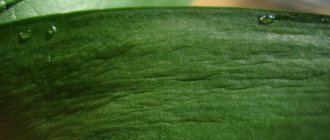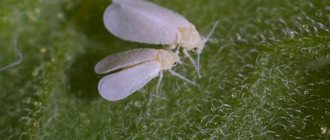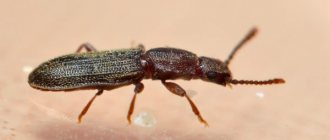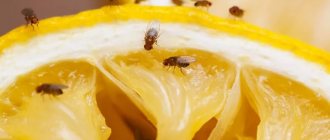Various pests strive to live next to humans: these are cockroaches, bedbugs, moths, and ants. This list can also include midges - small insects of the Diptera family. Science knows more than 1000 varieties of midges. There are black and green midges, whiteflies, and thrips. The flower midge is a pest of indoor plants; there is also a species that annoys animals; house flies living in apartments bite, spreading dangerous infections, especially when biting in the eye. And given the fact that, unlike mosquitoes, they swarm in a whole cloud, an insect attack can have very negative consequences.
About house midges
Midges can appear even in the apartment of the cleanest housewife. So one of its very common representatives are Drosophila - these are small insects, about 2 mm, that live in spoiled fruits or vegetables. It is with these products, purchased at the market or in a store, that pests most often enter the house. Drosophila do not pose a particular danger to humans, but they become one of the main enemies of garden and vegetable fruits. The appearance of such midges in flower pots with orchids and other plants is evidence of excessive watering of the flower.
The question of whether midges bite is puzzled by those who once discovered various kinds of rashes on the skin, accompanied by itching, burning, pain and swelling. It may seem strange to many, but there are also midges that can bite.
However, pests do not bite at night, as bed bugs do, but are active during the daytime. That's why they don't start in bed or bed.
Biting midges prefer damp places in the apartment, therefore, accumulations of adult individuals can often be found in the drain holes of sinks, as well as in the soil of indoor plants. They can enter the room through the ventilation system or fly in through a window from the street.
Black midges are much larger than fruit flies, their body length reaches up to 6 mm. Outwardly, they are very similar to flies; they can be house flies or earth flies. Pests do not dig into the skin with their stings like other insects, but gnaw out a piece of flesh, in place of which small wounds form. During an attack, the biting midge injects an anesthetic liquid. That is why the pain from a bite is not felt immediately, but after some time.
Saliva that gets into the wound often causes an allergic reaction. Multiple bites made by biting midges may be accompanied by fever, rapid heartbeat and enlarged lymph nodes.
Bites
Those who are faced with the appearance of midges in their apartment wonder whether midges bite. It does not dig in with its sting, but tears out pieces of skin, even microscopic ones. The midge is smaller in size than a mosquito, but bites much more painfully. The insect's saliva gets into the resulting wound and causes an allergy. It can manifest itself in various ways:
- Redness of the skin at the site of the bite;
- A small wound in the middle of a reddened area of skin over a large area;
- Burning and pain;
- Swelling of the tissue and itching in it;
- Various types of rashes;
- When scratching, the wounds may become covered with a black scab;
- With multiple midge bites, body temperature may increase;
- Heartbeat quickens;
- Lymph nodes are enlarged;
- The pressure drops.
Midge bites
Interesting! Midges do not bite at night when a person is sleeping in bed - they are active only during the day. That is why the bed and bedding are not of interest to this insect - while destroying the parasite, you can think about treating the bedroom.
Patients of allergists who came with complaints about biting insects and wondered why midges bite, because they do not eat meat. The fact is that many of these creatures are blood-sucking. By making a hole in the skin, midges feed on the droplets of blood that appear.
How to deal with biting midges in an apartment
Fighting midges at home
- Biting midges will not annoy apartment dwellers if you do not leave unsanitary conditions in the kitchen overnight: food on the table, dirty dishes in the sink, and waste in the trash can. After all, it is the smell of rot that attracts the attention of insects.
- In the kitchen, you should sort through and get rid of dirty bags and containers in which food was previously stored. It is advisable to treat the internal and external surfaces of cabinets with a vinegar solution, since midges are very afraid of its smell.
- Biting pests will not be able to fly into the apartment through the window or enter the room through the ventilation if they are protected by mosquito nets.
- If necessary, drain pipes under the kitchen sink should be cleaned, as food debris and moisture are the most favorable conditions for the spread of green midges.
- It is necessary to pay attention to indoor plants by adjusting their watering. You should also periodically loosen the soil and use drainage.
- Sticky tapes and traps that hang in places where they accumulate will help clean your apartment from biting midges.
- Pet cages also require regular cleaning. There is no need to leave stale fruits and vegetables in it.
- To prevent the midge from biting, you can catch it with a vacuum cleaner, subsequently cleaning the dust container outside.
- Folk remedies that have a pronounced aroma are also used against biting midges, which are usually found in every apartment. These can be garlic, horseradish, orange or clove sticks.
23.05.2019
How to get rid of midges that bite? - every housewife has asked this question at least once. Midges themselves are very small and difficult to detect immediately. But when they begin to bring discomfort into a person’s life, they should be gotten rid of immediately. Now there are enough chemicals and various methods with which it is easy to get rid of them.
A small insect can bite a person painfully
Preventive actions
Before you find out what and how to get rid of wine insects, it is worth considering preventive measures to avoid the appearance of individuals. They are simple and accessible to every housewife who dreams of a house without midges:
- the sanitary condition of housing must be normal;
- measures should be taken to prevent insects from entering from the outside;
- purchased fruits (vegetables) are thoroughly washed;
- fruits are stored in the refrigerator;
- the soil in pots with flowers is treated with a weak solution of manganese;
- garbage does not linger in housing.
To kill eggs laid on purchased fruits, they must be washed only with boiling water. The gifts of nature in the form of wild berries, the harvest of fruits and vegetables from dachas and vegetable gardens are no exception. Everything that is brought into the house should be quickly processed and recycled, or put in the refrigerator. Only slightly perishable foods are stored outside the refrigerator. Otherwise, the appearance of fruit flies is a matter of days!
Biting midges and methods of dealing with them
Midges belong to the family of dipterous insects. They reach about 6 millimeters in size. Outwardly they are very similar to flies, only smaller in size. The lifespan of these insects is no more than 1 month. Some midges cause harm to the human body. They carry various types of diseases. Their bite is much more painful and harmful than a mosquito bite, since the midge damages the surface of the skin. A person scratching a bite site can contract a disease such as simulidotoxicosis. These insects prefer damp places, so clusters of midges can be found in drains, sinks, and in the soil of indoor plants. They can appear in an apartment by flying through a window from the street or climbing up an exhaust pipe.
Blood-sucking bugs
Blood-sucking bedbugs are the only insects listed here that literally live in beds, sofas, bedding, and the folds of mattresses and pillows.
- The size of bedbugs most often varies between 5–7 millimeters, the bodies of females are rounded, those of males are more elongated, the color is brown, copper, or reddish-brown.
- The larvae look like smaller versions of adult bedbugs, but are lighter in color and smaller in size.
- Bed bugs leave behind a brown, corrosive dirt that is easy to find in places where insects accumulate.
- Bite marks look like swollen red dots, which always appear in several pieces and line up in a chain.
- When bugs puncture the skin, they inject an anesthetic into it, so the moment of the bite may not be felt; in larvae, this body system is underdeveloped, so their bites, on the contrary, can be painful.
Fleas
A person can be bitten by several types of fleas
and all of them are carriers of parasites and various diseases, from helminthiases to plague, borreliosis and various types of typhus.
- The size of fleas living in the Central region of Russia usually varies between 0.5–3 millimeters, so the insects look mostly like dark moving dots.
- A flea bite always feels like a sharp, burning pain at the site of the skin puncture.
- A small, hard, dried drop of blood may remain at the site of the bite.
- Insects are not particularly scrupulous in choosing a place on the body to feed on, so they can bite in any open areas of the skin.
- The flea bite begins to itch instantly and itch severely for several days.
Fleas do not tend to gather en masse to nest in a specific place, so they can live scatteredly anywhere in the house, not necessarily in or near the bed. If you suspect that it is fleas that are biting you, they live throughout the room.
Helpful advice
Lice
provoke the development of pediculosis and can be carriers of typhus and relapsing fever.
- Depending on the type of lice, the length of their light, oblong or round bodies can range from 1 to 4 millimeters.
- Most lice live directly on a person and constantly feed on his blood; body lice can live in things or a room, but not very far from the food source - a person.
- Lice bites are not felt, but after some time, which depends on the individual characteristics of the body, they begin to itch.
- If there are a large number of pests, their bites may merge into single red spots on the skin and become covered with a white flaky crust.
If you suspect that there are lice at home, you should start looking for them not from the bed or room, but from your own body. Insects can live on the head, eyebrows, mustache, armpits, groin, any place where hair is longer than 2-3 millimeters. Body lice can also be found on fleecy fabrics, which are similar in structure to hair.
Choosing methods for treating a midge bite
Treatment of bites by blood-sucking insects depends on the time of microtrauma, its location and symptoms. Therapy should be comprehensive, it includes:
- First aid
. It turns out after the first signs appear. Means with a local mechanism of action are used if changes affect only the area of damage. In case of systemic reactions, it is necessary to use those drugs that will stop the further development of allergies and intoxication. - Using medications to relieve swelling, redness, pain, and itching
. You can use both pharmaceutical ointments and solutions, and self-prepared products.
- Treatment of an infected wound
. It mainly involves the use of anti-inflammatory and antibacterial ointments. With a high, persistent temperature and severe signs of intoxication, doctors often recommend oral antibiotics.
You definitely need to drink more, this will speed up the removal of toxins from the body. You should not scratch the wound, as this will most likely lead to infection.
If the eyelid is affected, you cannot use products that are suitable for treating the skin. Drugs are needed that do not have a negative effect on the mucous membranes of the eye, so they must be selected especially carefully.
Midges
Midges in the house can be understood as pests that, according to the official scientific classification, belong to this family
, and in general small flying insects, the species of which cannot be determined by eye.
- Carnivorous midges can either tear out pieces of skin and feed on them, or drink blood.
- The skin reaction to a midge bite can be different and depends on the type of parasite; sometimes it can be a rounded red micro-abrasion that does not cause any sensation, sometimes it can be intense redness, itching and swelling of the skin several centimeters in diameter around the site of damage.
- , the bite of midges
in the Central region of Russia is not felt by humans. - You don’t need to look specifically for midges; if they are found in your home, you can easily notice them swarming or flying near the food that interests them.
Not all midges bite; many of them feed on indoor plants, microflora growing in damp places at home, your food and pet food. These types of midges can and should also be combated.
Recommended Links
What not to do after a bite
If you are bitten by black or green midges, it is important to remember what not to do:
- Treating the wound with household chemicals will increase the allergic reaction;
- Scratch the skin;
- Use a hormone-based ointment on the wound itself, as it causes a burning sensation, increasing healing time. Such drugs can only be applied around the affected area;
- If a midge has bitten you in the eye, you should not use alcohol-based compresses;
- Do not follow your doctor’s advice or recommendations for taking antibiotics;
- Use medications without the consent of a doctor.
Mosquitoes
Mosquitoes are a whole family of insects that feed on blood. They can enter your home through open windows and vents, through ventilation or drainage systems and are one of the most common pests in the warm season.
- Mosquitoes have dark gray bodies, up to 1 centimeter in length, and transparent wings located parallel to the body.
- Insects emit a characteristic monotonous squeak during flight, which is easy to hear if the parasite is hovering around your head.
- Mosquito bites are sometimes felt, sometimes not, it all depends on the individual sensitivity of the skin and where your attention is directed - most often, if people are passionate or busy with something, the moment of the bite goes unnoticed.
- The bite itself looks like redness that is dense to the touch, itches, and sometimes there is a small swelling around it, but in most cases it goes away after 1–4 hours.
Mosquitoes breed in water and places with high humidity, so they cannot literally live in your bed, however, it is more convenient for them to feed on your blood precisely while you are sleeping, so bites are often discovered in the morning.
Reasons for appearance
The fruit is just starting to deteriorate, and the insects are right there. Where do fruit midges come from when the rotting process begins:
- from kitchen trash cans, where they live in plant debris;
- from bathrooms with forgotten wet rags;
- from places where pets are located if their hygiene is not observed;
- from flower pots, over-watered, with rotting roots;
- from ventilation systems if neighbors violate sanitary standards;
- from the basement.
They multiply en masse in such places, waiting for the opportune moment of decomposition of plant tissue to occupy the fruit. But, let’s say, the apartment is in perfect order and everything is fine with ventilation, but if you forget the damaged object on the table, the insects appear.
How do midges form on fruit in this case? This is explained by the peculiarities of their reproduction process. Drosdophila is constantly engaged in laying eggs, which are not visible to the human eye due to their microscopic size. She does this on a still whole, healthy fruit.
As soon as it begins to rot, the process of reproduction of individuals begins, which occurs very quickly (in 24 hours) and begins exclusively with putrefactive changes. The rest of the midges that live nearby join in on the “feast” and lay new eggs, increasing their numbers.
Cockroaches
Cockroaches may begin to bite if their population in the house lacks other food or it is out of reach, or if they have already become accustomed to feeding on human and animal tissue elsewhere and then crawled to you. In practice, this rarely happens yet, but you cannot completely exclude the possibility that it is cockroaches that bite you in bed.
- The sizes depend on the type of cockroaches
, their gender and stage of development; they can be from 1.5 to 6 centimeters in length, on average about 2.5–4 centimeters. - The color can be red, black, brown, copper or brown.
- When a cockroach bites, it tries to tear off a piece of skin from you, so the marks of these attempts look like superficial, ragged abrasions of any shape.
- Sometimes a cockroach does not have enough strength to tear off that piece of skin that it has coveted, then a piece of it remains next to the wound and gradually dries out.
- If you have sensitive skin, dark spots similar to bruises may occur at the site of the bites.
If your bites fit the description of cockroach bites, carefully inspect the entire room where you sleep, as well as the kitchen and bathroom. If you have cockroaches, you are likely to find them when examining them in dark and damp areas of the apartment.
Recommended Links
How to remove swelling from a midge bite?
The midge, or midge, is a blood-sucking insect common in many regions. It feeds on the blood and lymph of the objects of its attack, and when it bites, it numbs the site of skin damage. Often this area of skin becomes inflamed and red, and the unpleasant consequences of the bite are accompanied by other, more serious symptoms. To take timely measures, you need to know how to remove swelling after a midge bite.
First aid and prevention
The first thing to do is to disinfect the bite site with alcohol or an antibiotic solution (Chlorhexidine, Miramistin). Then antihistamine ointment (Fenistil-gel) is applied to the skin to prevent tumors. If there is no ointment, you can treat the wound with brilliant green or a solution of baking soda. If the itching is severe or does not stop for a long time, you need to take an antihistamine tablet (Suprastin, Ketotifen, Cetrin, Claritin, Zodak, Zyrtec), even if there have never been any allergies before
This precaution will help reduce the size of the tumor after a bite or prevent its occurrence. It is better to choose 2nd generation drugs (Loratadine, Cyterizine)
They, unlike their predecessors, do not have a sedative effect and are better tolerated by patients. Also, for severe swelling, you should use hormonal ointments, for example, hydrocortisone ointment. Hormonal drugs of this group have a pronounced anti-inflammatory effect.
To prevent swelling from a midge bite from spreading, you can apply ice wrapped in a plastic bag and a clean napkin to the bite site.
Folk remedies for relieving swelling from a midge bite
Traditional recipes are used in addition to medications and cannot replace them. Most of these remedies effectively relieve swelling after a midge bite.
Traditional medicine recipes:
- Lubricate the bite area with thick foam from laundry soap.
- Apply crushed dandelion, plantain, mint, and bird cherry leaves to the bite site.
- Apply onion pulp to the swelling after the bite.
- Apply toothpaste or menthol rinse balm to the swelling.
- Apply a compress of grated raw potatoes to the tumor site.
Hives
The harmless urticaria butterfly has nothing to do with it; we are talking about one of the types of dermatitis, whose manifestations are easily confused with insect bites. Urticaria is characterized by red, itchy blisters that resemble nettle burns, which is where it gets its name. Most often, the disease is of an allergic nature, but blisters can appear without an obvious reason one at a time, several at a time, or en masse at once.
The main difference that allows us to distinguish this form of dermatosis from insect bites is that urticaria leaves blisters with a uniform surface; there is no visible point where the bite was made. It may be difficult to see with the naked eye, but a magnifying glass and phone camera can help you enlarge the blisters to the required size and thus more accurately determine their origin.
Carefully!
How to get rid of insects in bed?
To get rid of insects in bed:
- Unfold the sofa or bed, take out all the things from the drawers, remove the bedding.
- Carefully inspect each element separately for the presence of insects or traces of vital activity; it is most convenient to do this in daylight and using a flashlight.
- If you find pests, eggs or other signs of presence, take a vacuum cleaner with an empty dust bag and collect them, then remove the bag from the vacuum cleaner and dispose of it immediately.
The frame of a sofa or bed, storage boxes, slatted bottom and other structural parts of the sleeping place can be treated with insecticides in ready-made form against the type of pests that have settled in your home. Tools such as:
- Clean house
- Varan
- Combat SuperSpray
- Super cobra
- Dr. Klaus universal
- August Insecta
- Medilis-Superpower
- Raptor 17 types of insects
- Ra >
Use any product according to the instructions for its use. When handling, wear closed clothing, rubber gloves and a respirator to protect your respiratory tract.
Carefully!
To clean bedding or individual items from insects and traces of their presence:
- Place the item in a plastic bag, seal it tightly and place it in the freezer of a refrigerator at a temperature not lower than –15°C for 5–7 days.
- After the specified time has passed, remove the item, shake it over the bathtub, remove insect remains if there are any, and wash as usual.
- After washing, a clean item must be ironed at the maximum permissible temperature for additional disinfection.
Unfortunately, it is not always possible or advisable to clean bedding and accessories. If the dirt has become ingrained, if possible, throw away the damaged item and replace it with a new one.
All these instructions apply specifically to those cases when insects literally live in your bed. If you have established that at night you are bitten by parasites that live not in your bed, but in your room or the entire apartment, it will be necessary to fight them based on their type and lifestyle.
When trying to get rid of insects only in a bed, armchair or chair, remember that this may not be enough to get rid of the problem completely. Even if you manage to destroy insects precisely, there is no guarantee that they are not hiding somewhere else in the room or apartment. If this is the case, and most often this is the case, then some time after disinsection of the bed you will again begin to be bitten at night, because the vacant place of the destroyed insects will be taken by those that lived somewhere nearby. For this reason, it is always advisable to treat the entire apartment.
The fastest, easiest and most effective way to get rid of insects in your bed forever is to order the treatment of the entire apartment at the SES. You will still have to wash and freeze bedding and accessories yourself, but professional treatment will eliminate the likelihood of the problem reoccurring in the future.
Tips and tricks
- Take 100 grams of milk and 2 teaspoons of sugar, 1 tsp. pepper Soak toilet paper in this mixture and place it on a saucer.
- Place a piece of rye bread in a plate and pour the following solution over it: 3 tbsp. spoons of milk, 4 tsp. baking soda and ½ tsp. formaldehyde.
- Place a napkin soaked in 10 g of honey and 1 g of saccharin on the windowsill.
- Stick a match into the flower pot, sulfur into the soil, the fruit flies will die.
- An ultrasonic trap and cleaning the room with ultraviolet light, with a frequency of use once every 7 days, help a lot.
- Leave the kombucha overnight.
- Caught flies must be placed in the freezer for a while; they die instantly.
- In order not to throw away the glass jar with flies, you can place them in the microwave and turn them on for one minute (power 600). The flies die, and wash the dishes thoroughly with detergent.
- Mix apple cider vinegar with water and detergent and pour into a jar. Leave for several hours. Vinegar strongly attracts insects, and detergent will not allow them to get out. Renew the solution periodically (once every 7 days).
- Place the raptor plate in a sunny place. When heated, a pungent odor will be released, which is poisonous to fruit flies.
- Put the remaining horseradish in the bag, the midges will all disappear.
There are many and quite simple methods of dealing with uninvited guests. Choose what you like.











